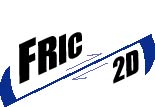 Chapter
1: INTRODUCTION
Chapter
1: INTRODUCTION  Chapter
1: INTRODUCTION
Chapter
1: INTRODUCTION Chapter Contents:
The development of FRIC2D was an integral part of Michele Cooke's Ph.D. work at Stanford University. In the course of her thesis she used this code to investigate several situations of frictional slip in the earth. This informal User's Manual was prepared by Michele Cooke and is based on the the user documentation developed by Jinhuo Liang for FRIC2D's parent BEM code, FRAC2D. Indeed, some parts of the code description are taken directly from the documentation of FRAC2D.
This document was created in HTML format. This format allows the user to more
speedily access portions of the documentaion of interest. The HTML version can
be accessed through the World Wide Web at URL: http://www.geo.umass.edu/~cooke/fric2d/doc.html.
Lisa Koenig formatted many of the figures of this text and edited the text.
Version 2.0 of Fric2d allows a more broad range of superposed gravitational loading than version 1.0, wihch was limited to lithostatic loading.
Beginner users who wish to create their own models might first read Chapters 3, 4 and 5 for sign conventions, elements, coordinate systems, units, and data file handling.
Users who are not familiar with the boundary element method and fracture mechanics should read Chapter 2 . A brief description of the theoretical background of FRIC2D is given in this chapter. Many of the sections in this chapter are identical to FRAC2D.
The complete description of all input commands is given in Chapter 4 . It is suggested that the user refer to Section 4.1 for a recommended sequence for entering input commands by function.
Post-processing of the results is described in Chapter 5 . The user can understand the self-explanatory output files and process the results using other commercial graphic-processing software.
cc fric2d.c getopt.c getwords.c -o fric2d -lm
where cc is the name of your C compiler,
On many computers, a makefile may be used to simplify the process of
compiling and maintaining FRIC2D. A simple makefile for a UNIX system
is given as follows:
runs fric2d using infile as the input file, outfile as the
file for the output data and graphicsfile as the file for the output
graphics.
While FRIC2D is running, updates are printed to
standard output. Information such as the current loading step and
iteration of convergence are printed to standard output (usually the screen)
This information informs the user about the progress of the process.
The run information can be send to a separate file using the following
command:
The file run.info will contain information about the process.
When no input or output files are specified, FRIC2D reads from the standard
input and writes to the standard output.
When FRIC2D encounters an error from which it cannot recover, it prints an
error message to the standard output (normally the monitor) and ceases
execution. If you don't know what the standard input and output are for
your machine, consult the documentation for your C compiler. For example,
suppose the first line of the input file, example.in, attempts to assign
an unknown constant
If you run FRIC2D on a UNIX machine using example.in as input file,
you will get the following results:
FRIC2D normally assumes that the names of input and output files are
supplied on the command line. If command line arguments are difficult
or impossible to supply on your computer, you may want to compile
FRIC2D using the fprompt option. FRIC2D will then use the standard
input (normally the keyboard) and standard output (normally the monitor)
to prompt you for input and output file names. If you don't know what
the standard input and output are for your machine, consult the
documentation for your C compiler.
# Makefile for compiling fric2d
# Source files
SRC = fric2d.c getopt.c getwords.c
# Object files
OBJ = fric2d.o getopt.o getwords.o
# Options (Flags) to be used by the C compiler
CFLAGS = -g -lm -I$(HOME) -sb
# Library to be used
LIB =
# Name of the C compiler to be used
CC = acc
# Building the executive code fric2d based on OBJ
fric2d: $(OBJ)
$(CC) -o fric2d $(OBJ) $(CFLAGS) $(LIB)
# C verifier lint to examine source files for potential errors,
portability problems
lint: lint $(SRC)
1.6 Running
On UNIX machines, you can run FRIC2D by typing the program name at the
system prompt. The program name may be followed by one or more options.
For example, the UNIX command:
fric2d -i infile -o outfile -g graphicsfile
fric2d -i infile -o outfile -g graphicsfile > run.info
no_such_constant = 100.0
All FRIC2D error messages begin with fric2d:. An error message
not beginning with fric2d: indicates that FRIC2D has encountered an error
that the programmer(s) did not anticipate.
Unix-prompt>fric2d -i example.in
fric2d: Unknown constant, or incorrect format (badfile.in, line 1)
no_such_constant = 100.0
Unix-prompt>
References
Crouch, S. L. and Starfield A. M., 183. Boundary Element Methods in
Solid Mechanics: with Applications in Rock Mechanics and
Geological Engineering. George Allen & Unwin, London, 322p.
Go to Chapter 2 ,
3 ,
4 , or
5